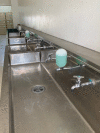Water, Sanitation and Hygiene (WASH) in Japanese elementary schools: Current conditions and practices
- PMID: 34787938
- PMCID: PMC9313865
- DOI: 10.1111/ped.15062
Water, Sanitation and Hygiene (WASH) in Japanese elementary schools: Current conditions and practices
Abstract
Background: Water, sanitation, and hygiene (WASH) is the foundation for preventing infectious diseases, as the current COVID-19 pandemic has shown. WASH is essential for school health, yet there have been very few papers published on WASH in Japanese schools. The objective of this review is to describe the current conditions and practices in Japanese elementary schools using an international framework for WASH in schools and identify implications for handwashing promotion in other areas.
Methods: This research was based primarily on a literature review. Information on common WASH practices was also collected through an international workshop attended by school health experts.
Results: There is a rigorous legal foundation for ensuring the physical infrastructure and quality control of a safe water supply in Japanese schools. Water quality is monitored regularly by Yogo teachers and school pharmacists. Strategic locations and an abundance of water supply infrastructure facilitate handwashing behavior. Hygiene promotion activities by Yogo teachers and student's health committees play a major role in increasing awareness, while health education classes provide minimal but necessary knowledge on handwashing with soap. Flush toilets are the standard, but there is still a demand for improvement of toilet facilities. Children's participation in daily cleaning of school toilets contributes to students understanding the importance of cleanliness.
Conclusions: Drawing from the Japanese example, WASH in schools' interventions are suggested to include laws and policies, a designated teacher, and children's participation to sustain both infrastructure and hygiene promotion.
Keywords: Handwashing; Japan; WASH in schools; Yogo teacher; school toilets.
© 2021 The Authors. Pediatrics International published by John Wiley & Sons Australia, Ltd on behalf of Japan Pediatric Society.
Figures
Similar articles
-
Assessment of the Status of Water, Sanitation and Hygiene (WASH) Services at Primary Schools in uMfolozi Local Municipality, Kwa-Zulu Natal, South Africa.Int J Environ Res Public Health. 2025 Feb 28;22(3):360. doi: 10.3390/ijerph22030360. Int J Environ Res Public Health. 2025. PMID: 40238358 Free PMC article.
-
Kenyan school book knowledge for water, sanitation, hygiene and health education interventions: Disconnect, integration or opportunities?Int J Hyg Environ Health. 2021 Jun;235:113756. doi: 10.1016/j.ijheh.2021.113756. Epub 2021 May 15. Int J Hyg Environ Health. 2021. PMID: 34004452 Free PMC article.
-
Assessment of Water, Sanitation, and Hygiene Conditions in Public Elementary Schools in Quetzaltenango, Guatemala, in the Context of the COVID-19 Pandemic.Int J Environ Res Public Health. 2023 Oct 13;20(20):6914. doi: 10.3390/ijerph20206914. Int J Environ Res Public Health. 2023. PMID: 37887652 Free PMC article.
-
Water, Sanitation and Hygiene (WASH) in Schools in Low-Income Countries: A Review of Evidence of Impact.Int J Environ Res Public Health. 2019 Jan 28;16(3):359. doi: 10.3390/ijerph16030359. Int J Environ Res Public Health. 2019. PMID: 30696023 Free PMC article.
-
Preparing schools for future pandemics: Insights on water, sanitation and hygiene solutions from the Brazilian school reopening policies.Int J Hyg Environ Health. 2024 Apr;257:114325. doi: 10.1016/j.ijheh.2024.114325. Epub 2024 Feb 7. Int J Hyg Environ Health. 2024. PMID: 38330729 Review.
Cited by
-
Enhancing the effectiveness of infectious disease health education for children and adolescents in China: a national multicenter school-based trial.BMC Public Health. 2023 Jun 15;23(1):1161. doi: 10.1186/s12889-023-16000-3. BMC Public Health. 2023. PMID: 37322442 Free PMC article.
-
Understanding COVID: Collaborative Government Campaign for Citizen Digital Health Literacy in the COVID-19 Pandemic.Life (Basel). 2023 Feb 20;13(2):589. doi: 10.3390/life13020589. Life (Basel). 2023. PMID: 36836945 Free PMC article.
-
The effects of skill-based health education-A randomised-controlled intervention in primary schools in rural Bangladesh.PLoS One. 2025 Jul 11;20(7):e0327325. doi: 10.1371/journal.pone.0327325. eCollection 2025. PLoS One. 2025. PMID: 40644507 Free PMC article. Clinical Trial.
References
-
- Centers for Disease Control and Prevention . When and how to wash your hands. [Internet] Atlanta: Centers for Disease Control and Prevention; 2020. [Cited 6 June 2020]. Available from: https://www.cdc.gov/handwashing/when‐how‐handwashing.html
-
- COVID‐19 Hygiene Hub . Fighting COVID‐19 through hygiene. [Internet] COVID‐19 Hygiene Hub; 2020. [Cited 20 July 2020]. Available from: https://hygienehub.info/en/covid‐19
-
- Curtis V, Cairncross S. Effect of washing hands with soap on diarrhoea risk in the community: A systematic review. Lancet Infect. Dis. 2003; 3: 275–81. - PubMed
-
- Greenland K, Cairncross S, Cumming O, Curtis V. Editorial, Can we afford to overlook hand hygiene again? Trop. Med. Int. Health 2010; 18: 246–9. - PubMed
-
- Jamieson D, Bremen J, Measham A, Alleyne G, Claeson M. Disease Control Priorities in Developing Countries. Oxford University Press, Oxford, 2006. - PubMed
Publication types
MeSH terms
LinkOut - more resources
Full Text Sources
Medical



